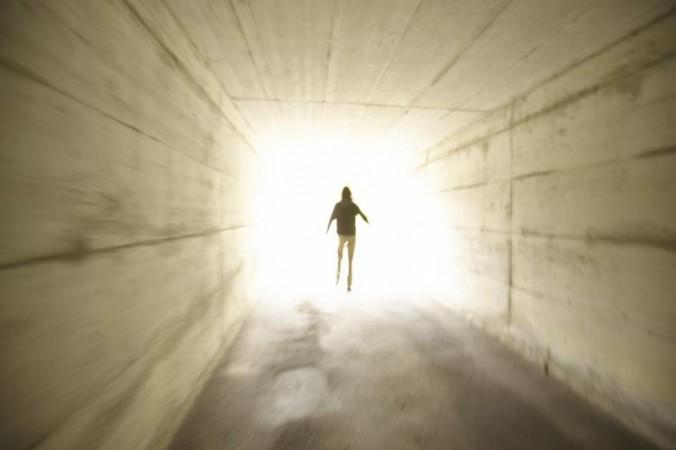This article is the second of our five-part series on near-death experiences, exploring decades of research on the topic. Click HERE to start with Part 1.
DURHAM, N.C.—It was 1993. Kathleen Elmore was driving through an intersection and a truck came at her from the left. “That doesn’t look good,” she thought.
“Dying does not hurt,” Elmore said as she recounted the experience at the International Association for Near-Death Studies (IANDS) conference this year.
“That whole immense, huge impact felt like somebody just kind of tipped me on the shoulder, and I went straight up.”
Elmore said that her consciousness went 50 or 60 feet up into a beautiful white light where she felt “incredible love” and heard beautiful music. There she met three beings who are “beyond angels,” she said, and who had helped plan her life before she was born. She had a conversation with them while watching people rescuing her down below. After she came back to life, she gained the ability to see the energy around the earth and people’s collective consciousness, she said.
Episodes that people experience when they are clinically dead or close to clinical death are dubbed near-death experiences (NDEs) in the 1975 book “Life After Life” by Raymond Moody, M.D. and Ph.D. in philosophy and psychology. The book has drawn academics to study the phenomenon, and led to the foundation of IANDS in 1981 to facilitate near-death research. On Sept. 2–4, near-death experiencers (NDErs) and researchers gathered in Durham, N.C., to share their experiences and findings over the past 30 years.
In Part 1 of this series, we mentioned that Eben Alexander, M.D., had an NDE while his brain was damaged by acute bacterial meningitis; and that Bruce Greyson, M.D. and director of the Division of Perceptual Studies at the University of Virginia, reported that NDErs’ mental functioning is, in most cases, better during the NDE than usual, and that they can still remember their NDEs very accurately 20 years after the event.
In this part, we look at the validity of NDEs through their aftereffects on NDErs.
The Study of Aftereffects
During his talk at the IANDS conference, Greyson mentioned that some “pseudo-skeptics,” as he calls scientists not open to NDE discoveries, believe that the NDE phenomenon is not something that can be studied scientifically because NDEs are not something material, and they cannot be measured.
Greyson argued that there have been a lot of studies done on emotions, though they are not known to be of material existence.
“Are love and fear material?” he asked. “There’s certainly a lot of scientific research about these things. We can’t see them, but we can certainly measure the aftereffects, and from their effects, we learn, scientifically, a lot about them.”
In scientific study, there are many things that we measure indirectly. For example, physicists’ study of dark matter is not through the direct observation of its existence, but through indirect means such as calculating the discrepancy of a cosmic body’s mass estimated in different ways.
Last week, NASA announced that its Kepler mission confirmed the existence of an invisible planet, Kepler-19c, by observing the orbit cycle of a nearby planet, Kepler-19b, which is seen to be influenced by an unknown gravitational force.
The Kepler team also published a paper in the journal Science on Sept. 16 about the discovery of the planet Kepler-16b orbiting two low-mass suns. The discovery was made from eclipses, some of which were due to the two suns obscuring one another.
Using the bubble chamber as an analogy, Greyson argued that NDE can be studied scientifically. A bubble chamber is a vessel in which subatomic particles are made to pass through a liquid, leaving a trail of bubbles on their tracks. The particles are too small and move at too fast a speed for us to observe, but by observing the bubbles that form around their tracks, we can learn about them. Similarly, Greyson said, we can learn about NDEs from their aftereffects.
“For true scientists, the ultimate authority is experience, not theory,” he said.
Some may think that NDErs must be religious to start with, and their experiences could be their imagination. However, there are NDErs who weren’t religious before their NDEs, and Greyson has found that one of the aftereffects of NDEs is a lowered religiosity. Interestingly, NDErs also generally have an increased spirituality after their NDEs.
Another thing that Greyson has found in his research is that, contrary to what most would expect, NDErs are more inclined to use logical thought after their NDEs than before their NDEs.
Apart from psychological changes, electromagnetic aftereffects are widely reported. When some NDErs wear wristwatches, the batteries run down very quickly, or the watches keep a faster or slower time than normal. Some NDErs make light bulbs go out, or TVs and radios might change stations when they pass by. Greyson mentioned that one NDEr cannot be detected by automatic doors.
Jane Katra, Ph.D. in Public Health, who also spoke at the conference, said that she became sensitive to vibrations and electromagnetic fields after her NDE, and it was difficult for her to adjust to living in her parents’ house because she became able to hear various things from different rooms.
These aftereffects of NDEs make it difficult for one to deny NDEs as real experiences, because mere hallucinations or being close to death would not bring such effects.
Greyson and Mitchell Liester, M.D., are starting a study on the electromagnetic aftereffects of NDEs. Following the data collection from a questionnaire, they will conduct studies measuring NDErs’ electromagnetic fields and effects on watches.
Read from the beginning of this series HERE.

